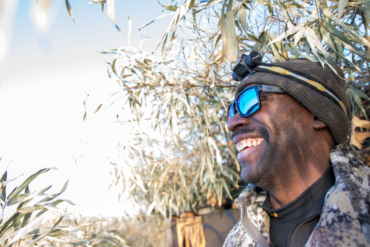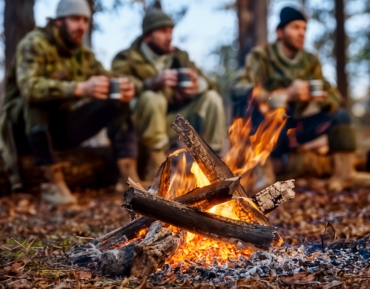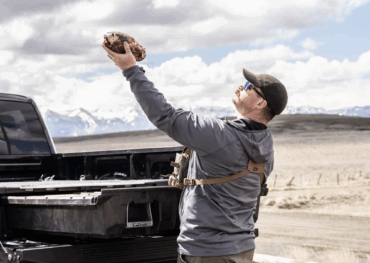From rods to rod-holders to bait aeration, GearJunkie contributor Elliott Stark can help you get started with a surf fishing kit.
Surf fishing is perhaps the most geographically available type of fishing in the world. Anyone who can get to the beach can cast into the surf and catch some type of fish or other. Depending on your location, shoreline fish are some of the best-tasting, hardest-fighting fish in the sea.
What follows is a guide to putting together a surf fishing setup that will prepare you no matter where you live.
A Guide to Surf Fishing Rigs & Gear
Choosing Surf Fishing Rods & Reels
In most places where you can surf fish, there will be the opportunity to catch big and small fish. As such, buying three or four rods and reels of varying sizes will be your best bet.
You might consider buying one large, two medium/all-purpose, and one lighter tackle outfit. Depending on your fishing experience level, your best bets are either spinning or conventional tackle.
Conventional reels hold a bit more line but can be the most difficult to cast (the inexperienced angler will backlash a few times before getting the hang of it). Spinning reels are great too. You can put quite a bit of drag on fish, and, using braided line, you can also pack lots of line on the spool.
Your light tackle outfit will likely be a baitcasting or light-action spinning reel spooled with 12-pound mono or 10-pound braid. You can get a light- to medium-light-action rod. This will be good for casting small lures or bait to small and medium-size quarry.
The following are a couple of good options:
- Light option: Shimano Stradic 4000 reel with medium-light action rod
- Medium: Shimano Bait Runner 5000 Combo
Both of these rods and reels are castable and useful for a variety of scenarios. If you’re interested in tangling with big sharks from the beach (fish that might weigh 300 pounds or more), there’s quite a bit in the way of larger rods and reels that are well-suited for this application.
DIY or Buy Rod-Holders
One of the best things about fishing in the surf is being able to set up pole-holders in the sand. The sight of a rod arching and a drag screaming as a fish strikes are among surf fishing’s most iconic images.
Rod-holders can be simple or complex. For the DIYer, just pick up some 3-inch-diameter PVC pipe from the hardware store. You can then measure 3.5 feet of it and cut it at a 45-degree angle. The result is a rod-holder that can stick into the sand on one side while accommodating the rod butt on the other.
If you don’t feel like breaking out the hacksaw, you can also buy your own rod-holders. Here are a couple of good options:
Bait & Bait Storage
Your ultimate choice in bait will likely depend on where in the country you’re fishing. The general idea is to “match the hatch” and use whatever sort of local forage fish are available at the beach you’re fishing.
If you’re on the Gulf Coast, that might be mullet and shrimp. If you’re in the Northeast, that might be menhaden.
When it comes to natural bait, you can opt to use it live, dead, or cut into chunks. Each option has its benefits. And, if possible, you might consider deploying a combination of offerings spread across many poles.
The best and most cost-effective choice for live bait fishing is to catch your own. The best way to do this is by learning to throw a cast net. Cast nets are not only quite a bit of fun to throw (once you get the hang of them), but you never quite know what you’ll catch. If you’ve never thrown a cast net, here are some instructional videos.
Depending on how tall you are, you might start learning on a 5- or 6-foot net. For most occasions, opt for a three-eighths-inch mesh size. The Fitec EZ Throw is designed for beginning castnet throwers. The Fitec 6-foot Super Spreader is another great option.
If you don’t feel like going the cast net route, you can also buy bait from your local bait and tackle shop. The added benefit of this approach is that these fine people can give you pointers on what’s biting and where. They can also sell you a castnet and all the tackle you’ll need.
Bait Bucket & Aeration

Whether you’re catching or buying your bait, you’ll need somewhere to store it and to keep it alive. Your best bet is a bucket-and-aerator combo — don’t forget the lid. Portable, battery-powered pumps that shoot air into your bucket through a hose, which terminates in an air stone that diffuses it into the water, aerators are inexpensive and pay for themselves quickly.
For most scenarios, a 5-gallon bucket is your best bet. You can buy the $4 model from your local home improvement store or even an old pickle bucket you can sometimes find at your favorite deli. If you want a bit more out of your bucket, the YETI LoadOut is near indestructible.
Aerators are an important consideration to keep your live bait alive. Perhaps the most commonly used is the Bubble Box from Marine Metal Products.
Other Surf Fishing Must-Haves

If you’re going to carry your whole kit down the beach, a wagon will come in handy. You can use one of the old-school red ones or buy a purpose-built beach hauler — like this one.
You’ll also need a cooler, a bait knife or two, and some needlenose plyers. You can grab everything you need by way of a multitool from Gerber.







